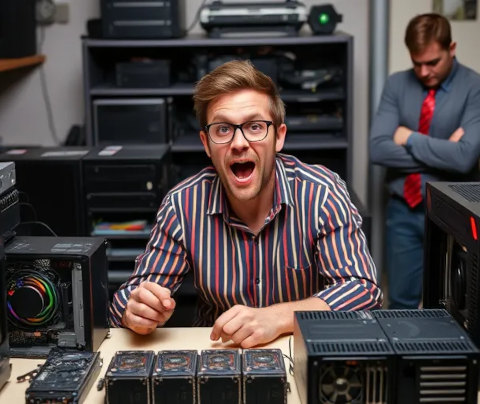This really depends on what you mean when you say that a Celeron N100 mini PC isn’t enough. If an N100 mini PC isn’t powerful enough, you can spend a bit more on a Ryzen 5560U mini PC that is more than twice as fast, or splurge on a mini PC with a Ryzen 7840HS that is more than four times faster. Heck! You could buy a stack of four N100 mini PCs, or you can mix and match models to fit your unique needs!
Maybe that isn’t what you mean. Maybe you need to cram in more hard drives to store backups, the videos you record yourself on your vlogging camera, or movies and TV shows you acquire on the high seas. You should have no shame in hanging a big USB hard disk off the back of your mini PC, but if that isn’t enough, what are you supposed to do?

You can definitely build something for your homelab that is much more well equipped than a mini PC, but you can also keep your up-front costs and electricity bill down by sticking with a mobile CPU like the Intel Celeron N100. You just have to upgrade your form factor!
My friend Brian Moses has been using, buying, and selling all sorts of mini-ITX motherboards with low-power CPUs, lots of 2.5-gigabit Ethernet ports, and plenty of SATA ports.
You can probably build what you need, and it might only be as big as two or three stacked shoe boxes. That isn’t as small as a stack of mini PCs, but it isn’t exactly huge!
- Brian Moses’s eBay store
- Is It Safe to Use a Big, Honking USB Hard Drive on Your Raspberry Pi Server?
- I Added A Refurbished Mini PC To My Homelab! The Minisforum UM350
Why is the Intel Celeron N100 so popular now?
Brian and I have both been excited about the various small form factor motherboards built around mobile CPUs for a long, long time. I built my homelab server around a motherboard that was rocking an AMD 5350 processor nine years ago, and Brian put together one of his DIY NAS builds a few years ago based around an Intel N5105 CPU.
I could write an entire blog post about how much of a bummer it was that there weren’t any good homelab or NAS motherboard choices with mobile CPUs in the seven years in between our two builds. Instead, I am just going to say that it is fantastic that power-sipping CPUs are showing up on motherboards again, and they have been showing up on motherboards with plenty of SATA ports. There’s no shortage of homelab-friendly mini-ITX motherboards to choose from today!
The Celeron N5095, N5105, and N6005 had some minor popularity, but not nearly as much as the Celeron N100. I can’t explain why. The Intel N100 is an incremental evolution over the N5095 and not some sort of revolution. It is only better in the ways that you would expect from a processor released two years later: it is a little faster and a bit more power efficient.
The previous generation is every bit as useful as the Intel N100. I imagine it just took a few years for everyone to start catching on, and the Intel N5095 that started the party is now just too old to be as relevant.
You didn’t answer the question, Pat!
You are right. Sorry about that!
The Celeron N100 is awesome because it is a little less than half as fast as a Ryzen 5600 desktop CPU, and you can get an entire mini PC with an N100, RAM, and storage for about the same price! The Intel N100 has a fantastic little GPU with more than enough video-encoding capacity to transcode several 4K Jellyfin or Plex streams. You can upgrade them to 48 gigabytes of RAM. They are also reasonably priced. You can usually buy a mini PC with RAM and storage for $145.
UPDATE: The Trigkey N100 with 16 GB of RAM and 500 GB NVMe has been going on sale almost once a week for less than $140. Sometimes as low as $134 shipped!
My own Intel N100 router-style mini PC idles at around 8 watts. That is the whole thing: motherboard, network interfaces, RAM, NVMe, and the CPU. It is using half as much electricity as a modern LED light bulb. Adding the external 14-terabyte hard disk drive brings that up to about 15 watts.
All of this applies to the Intel N5095 and its siblings.
You can go a long way with just a mini PC!
Everyone’s needs will be a little different, but 32 GB or 48 GB of RAM paired with an N100 is a pretty reasonable ratio of RAM to CPU horsepower, and so is 64 GB paired with a Ryzen 5560U. You can fit a lot of light- or medium-duty virtual machines and containers on these tiny boxes! What about storage?
I had a RAID array at home from the late nineties right up until just a few years ago. They just didn’t make large enough hard drives to hold all my data. The options were to manually split things between drives, or bundle them all together in a RAID and just dump everything in one place. I chose the latter because it also adds redundancy.
Hard drives have been getting bigger at a rate that exceeds my needs, so I am using single USB hard disks on each of my mini PCs and in my personal desktop computer. A copy of all my data lives on a 14 TB USB hard drive attached to the N100 mini PC at my house, and another copy lives on a 14 TB USB hard drive attached to a Raspberry Pi at Brian Moses’s house. The original copy of that data lives on a 12 TB SATA hard disk in the computer I am sitting at right now.
Assuming they survive long enough, those 14-terabyte disks will be rather old by the time I fill them up. When I do, I will be able to replace them with 30 terabyte disks.
What if I don’t like the idea of USB hard drives? What if I need way more storage than that?!
I haven’t had any real issues with the USB hard drives on my servers in the last four years. The USB disk on my N100 Proxmox server can read and write data at just over 200 megabytes per second, which is pretty close to the maximum speed of the drive that came in Western Digital’s enclosure. I have no qualms about recommending this configuration to other people.
I also don’t want to twist your arm! If you want to build a RAID using Linux’s mdadm or ZFS, I surely don’t want to stop you!
You don’t have to give up the power-sipping Intel N5095, N6005, or N100 to do that. If those offer enough horsepower for your needs, you can start shopping for a mini-ITX motherboard and a nice little case. There are plenty of options to choose from.
I like Brian Moses’s new off-site buddy NAS build!
I am not just saying this because I host Brian’s off-site NAS at my house. Many of the choices Brian makes in his builds can be attributed to my own recommendations, thoughts, and insights. In the case of the current iteration of his off-site NAS, my contribution was me exclaiming, “OMG Brian! You are absolutely correct! That 3D-printed NAS case from makerunit looks awesome!”
Brian has been selling Celeron N5105/N6005 and N100 motherboards in his eBay store for quite a while now. He wound up pairing one of those Celeron N6005 motherboards with six refurbished 12-terabyte SATA hard drives. He is running TrueNAS Scale and connecting to his other devices using the awesome Tailscale mesh VPN.
These Celeron N5105, N6005, and N100 motherboards from Topton are all awesome. You get six SATA ports, multiple m.2 NVMe slots, and four 2.5-gigabit Ethernet ports. They squeeze a lot of hardware into a small space, and they manage to utilize every one of the limited number of available PCIe lanes on these mobile processors.
It is a fantastic little server. Brian printed his case using two different shades of blue PETG filament, and he has his face logo on the front.
The makerunit 6-bay NAS case’s front cover is held on by magnets, and you can slide any of the six hard drives right out if you need to replace them. It might not be quite as slick as a case with real hot-swap drive bays, but it costs less than two rolls of filament, and it looks super cool!
The case has room for a full-height single-slot PCIe card, so you might be able to sneak in a slim GPU for some machine learning shenanigans. You really need at least 24 gigabytes of VRAM to run the more serious LLMs, but you can fit some really useful stuff into 8 or 12 gigabytes.
I don’t believe that you will find room to squeeze a GPU into the Topton N100 motherboards. It does have a 1x PCIe slot, and that would actually be just fine for running large language models that completely fit on one GPU, but you’re going to have clearance issue with other ports on the motherboard.
- 3D-Printed NAS CASE 6-bay (+3 SSD) by makerunit at Printables
You don’t have to 3D-print a case
Finding cool new uses for your 3D printer is fun. So is finding a good excuse to buy a 3D printer, and I think all of makerunit’s cases qualify here. Even so, you still don’t have to 3D-print a case. There are no shortage of awesome mini-ITX and micro-ATX cases to build a compact NAS or homelab server around.
I am a fan of all the NAS cases from Jonsbo. The Jonsbo N1 and Jonsbo N2 look equivalent according to the spec sheet, but they each have a very different vibe, and they lay out the major components in very different ways. The Jonsbo N1 looks like something out of a sci-fi movie, while the Jonsbo N2 is a more functional and usable NAS case. I could argue with going with either one.
The Jonsbo N3 looks a lot like the Jonsbo N2. The Jonsbo N3 bumps you up to 8 hot-swap 3.5” hard drive bays instead of 5, and it gives you room for a dual-slot full-height PCIe GPU. Then there’s the even larger Jonsbo N4 that gives you room for a micro-ATX motherboard and a wide half-height GPU.
Or you can follow Brian Moses again and go even larger. He migrated his personal DIY NAS to a SilverStone CS382. It has 8 hot-swap 3.5” drive bays, room for a micro-ATX motherboard and full-size ATX power supply, and he is using an Icy Dock to squeeze eight additional 2.5” SATA SSDs into the single available 5.25” optical drive bay.
The SilverStone CS382 is a big case. That not only buys you room to fit your hands inside the machine when you need to work on things, but it also gives you room for a huge GPU and a less expensive and more capable ATX power supply.
- Migrating my DIY NAS into the Silverstone CS382 with help from the Icy Dock ExpressCage MB038SP
- I Am Trying To Win Brian Moses’s DIY NAS 2023 Giveaway!
- Jonsbo N1 Mini-ITX Case at Amazon
- Jonsbo N2 Mini-ITX Case at Amazon
- Jonsbo N3 Mini-ITX Case at Amazon
- Jonsbo N4 Micro-ATX Case at Amazon
There’s an option between a full mini-ITX NAS build and USB hard disks!
Topton makes a nifty little server, the R1 Pro, that we lovingly refer to as “the toaster NAS”. Why do we call it that? Because the pair of 3.5” SATA hard disks slide in from the top like two pieces of bread! It is reasonably priced, quite compact, and it sips power. Brian stocks them in his eBay store, but they are also available with different branding on Amazon and Aliexpress.

The toaster NAS features the Intel N100 processor, one DDR4 SO-DIMM slot, one m.2 slot, and a pair of 2.5 gigabit Ethernet ports. It is basically a mini PC sandwiched between two hard drives but wrapped up in an attractive shell.
This is a fantastic middle ground between a basic mini PC and a 5-bay mini-ITX home server. Depending on how you are measuring things, you could almost fit four of these in the space that Brian’s 6-bay makerunit NAS is taking up under my network cupboard.
- Topton 2-Bay R1 Pro NAS review at Brian’s Blog
- Topton 2-Bay R1 Pro NAS at Amazon
- Topton 2-Bay R1 Pro NAS at Aliexpress
Can we trust these motherboards from Topton?
I have to admit that when I first heard about these motherboards a few years ago, I was worried that they’d be sketchy. You had to order them from Aliexpress. Who the heck is Topton? Do they make a reliable product? Will I have to ship it back to China if it doesn’t power on? What if it stops working in a week?
Then Brian bought one and used one. A few of our friends tried them, too, and we got more confident. We started hearing DIY NAS success stories. Then Brian started importing them by the dozen selling them in his eBay store, and we didn’t have to worry about something going wrong between us here in the United States and China, and we didn’t have to wait two or three weeks for the motherboard to show up. This helped a lot!
Today we know that Brian has shipped hundreds of Topton mini-ITX motherboards to customers. I spoke with Brian about failure rates and returns on more than one of our weekend pizza nights here at my house. I don’t want to blabber about specific numbers that I may or may not have been told in confidence and that I may not be remembering precisely, but I think it is safe for me to say that he has had some returned motherboards, and I believe every one of his very small number of returned motherboards worked just fine when he tested them.
We’ve gone from an anecdote, to anecdata, to real data over the last few years. At this point, I would try any of Topton’s motherboards without hesitation.
All of this advice works in reverse
I am not entirely certain that whatever insights this blog post provides qualify as advice, but I am going to refer to it as such anyway!
Maybe you have a huge but aging NAS in your home. Maybe you have a short stack of rack-mount servers in your closet. Perhaps you’ve been planning to downsize during your next upgrade, but you were planning to move from one or more giant 4U servers into something like the Jonsbo N2 or makerunit’s 6-bay 3D-printed case.

Is it possible that this is bigger than you need? You might be better served with a toaster NAS and a couple of Trigkey or Beelink Intel N100 or Ryzen 5560U boxes in a little Proxmox cluster that would all fit inside your childhood Return of the Jedi lunch box. You may be better off with just a stack of mini PCs.
The neat thing is that there are no wrong answers. As long as you are treating your valuable data correctly and you have good backups, then getting everything else perfectly optimal is much less important. You can just do whatever seems fun, interesting, or useful to you!
Conclusion
We’ve explored a world of options here, from the humble USB hard drive to the spacious SilverStone CS382, and many options in between. There’s no single right answer when it comes to building your ideal homelab or NAS setup. The best choice depends on your unique needs, budget, and even your personal aesthetic preferences. Maybe you’re drawn to the sleek minimalism of a mini PC, or perhaps you crave the expandability of a larger case.
Whatever path you choose, remember that the journey is as important as the destination. Don’t be afraid to experiment, to try something new, and to learn along the way. Embrace the challenges and celebrate your successes. And most importantly, share your experiences with others!
Join the Butter, What?! Discord community and connect with a passionate group of individuals who are just as excited about homelabs as you are. Come share your builds, ask for advice, and learn from the collective wisdom of the group. Let’s build something awesome together! And don’t forget to leave a comment below and tell us what you think of this exploration of mini-ITX options. What are your favorite builds? What challenges have you faced?
- Topton DIY NAS Motherboard Rundown!
- Topton 2-Bay R1 Pro NAS review at Brian’s Blog
- DIY NAS: 2023 Edition
- Migrating my DIY NAS into the Silverstone CS382 with help from the Icy Dock ExpressCage MB038SP
- I Added A Refurbished Mini PC To My Homelab! The Minisforum UM350
- I Am Trying To Win Brian Moses’s DIY NAS 2023 Giveaway!
- Is It Safe to Use a Big, Honking USB Hard Drive on Your Raspberry Pi Server?
- Two Weeks Using The Jellyfin Streaming Media System
- Brian Moses’s eBay store
- 3D-Printed NAS CASE 6-bay (+3 SSD) by makerunit at Printables